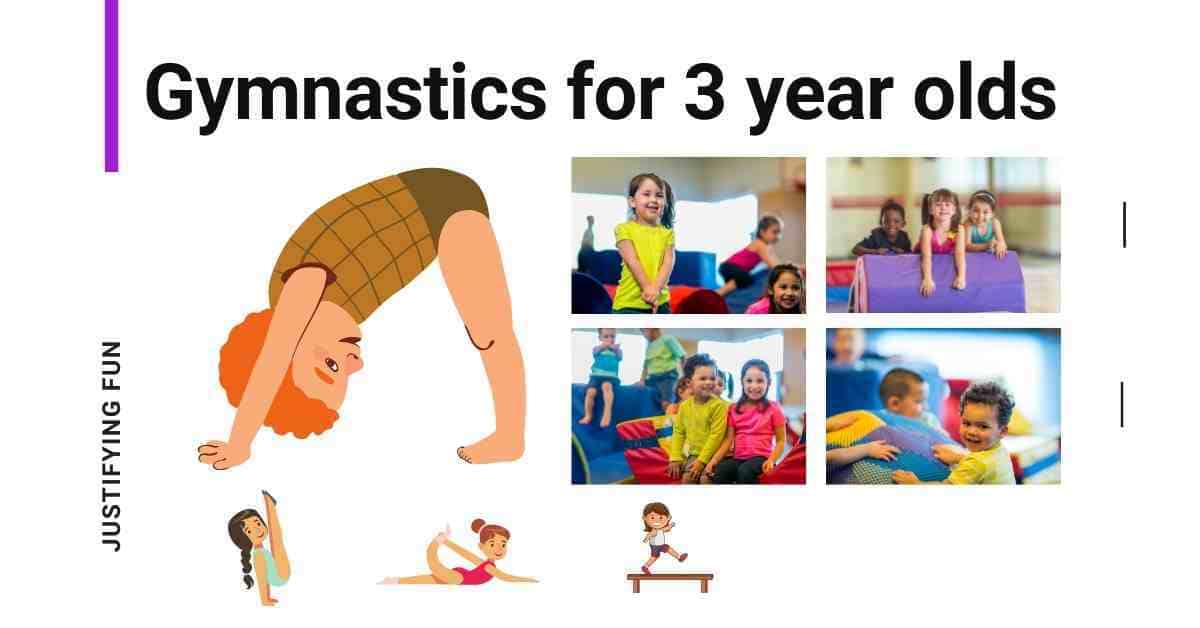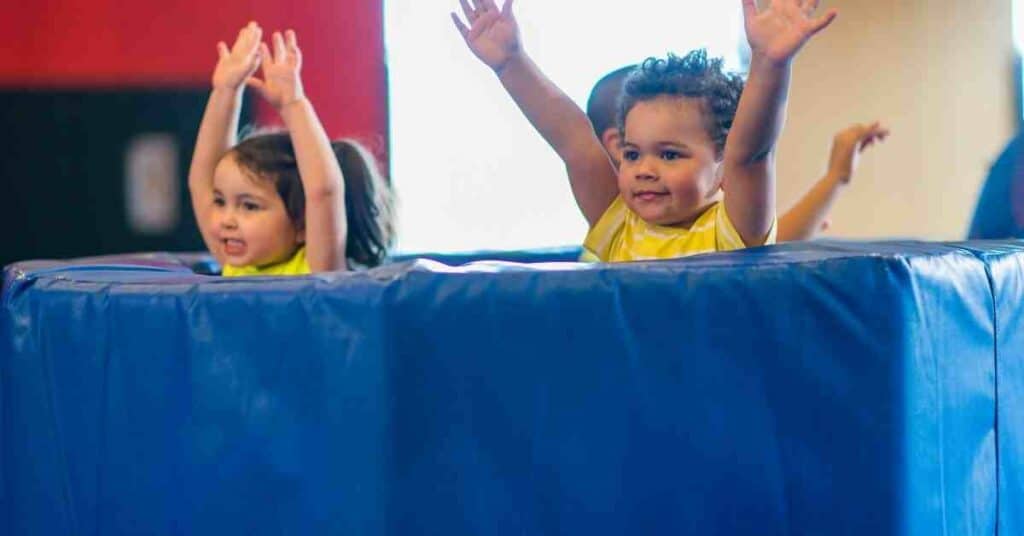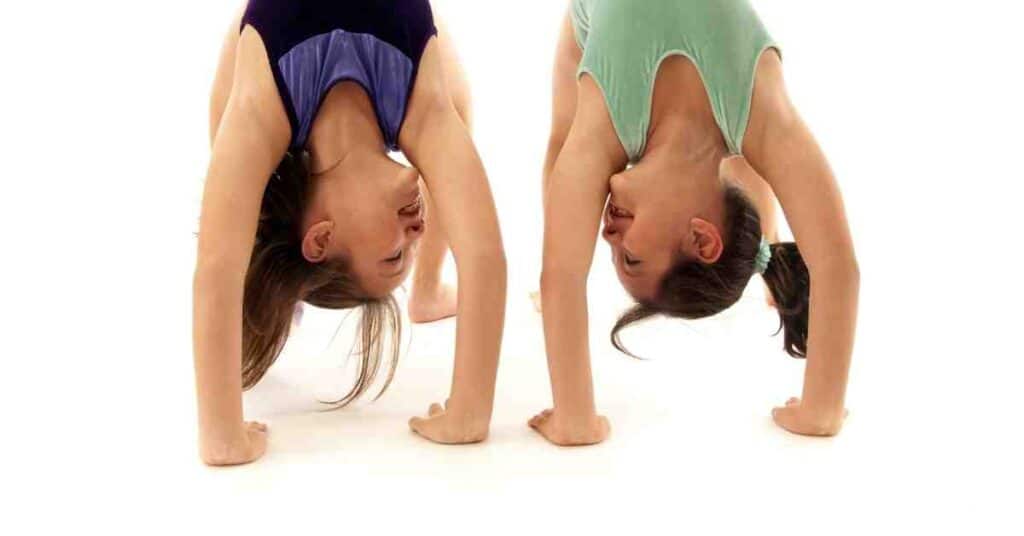
Once your bundle of joy learns to walk, it’s not long before they are 3 years old and full of boisterous energy with heaps of curiosity to match their increased mobility. They require constant engagement with enriching activities. These should not only boost their brain capacities but also help them develop their motor skills, strengthen muscles and learn a little discipline.
Gymnastics can be a great way to give your 3 year old all of these and more. Plus, they will learn a valuable skill with health benefits that have the potential to linger well into adulthood. For example, maintaining flexibility reduces injury, improves mood and promotes proper posture, among many other benefits. We wrote about the benefits of gymnastics a while ago and found some great benefits for toddlers taking part in recreational toddler gymnastics classes.
Is gymnastics good for a 3 year old?
Gymnastics is good for a 3 year old. At 3 years old toddlers aren’t taking gymnastics seriously, in the same way that a child who is 5 or 6 years old might be able to focus and being to work through the gymnastics levels. At 3 years old, gymnastics is a chance to socialise, learn some coordination skills and try out a new hobby that can be a lot of fun. Toddlers gymnastics classes are full of cheese mats, inflatable balls and other fun equipment that make gymnastics even more exciting for a toddler. Let’s take a closer look at what a 3 year old might learn at gymnastics class.
What Gymnastics Teaches Three Year Olds
They will learn basic techniques such as stretching, rolling, jumping, balancing and swinging. Through repetition, they’ll acquire discipline while developing memory recall and motor skills. Plus, it gives your three-year-old a place to expend all their exuberant energy in an effective, constructive and healthy way.
Important Life Skills

They’ll learn healthy exercise habits, develop self-confidence and gain strength. These will culminate into an invaluable and essential understanding of overcoming obstacles, challenges and failure. All of this falls under the banner of what most children consider playtime. So, they’ll have fun learning these things.
Essential Motor and Cognitive Abilities
Other crucial skills will develop as a ripple effect of doing gymnastics. Flexibility, power, gracefulness, endurance, coordination and balance are just some of these. Actually, it’s ideal for three-year-olds who tend to be more clumsy than the average. Gymnastics will give the impetus to extend these skills into their daily activities.
When children get both their body and mind to work simultaneously, magical things can happen. Cognitive functioning and discipline are two of these. This is ideal if your little angel tends to be hell on wheels. Self-regulation of their own behavior is an invaluable asset, especially when they start going to school regularly.
Socialization Skills

Plus, because other children are present, it’s a great way for them to socialize with others their own age. Sharing, taking turns and teamwork are some of the benefits to children in this regard. Also, refined communication skills come about as a direct result of interacting with others.
Encouraging Gymnastics
But, just because you think it’s a good idea for your child to get into gymnastics doesn’t mean she/he will agree. Some children will jump at the opportunity head first without any qualms or issues. However, for other kids, it will take some time to get them amenable to the idea. If they like gymnastics starting at a young age will set them up nicely for starting the gymnastics levels when they grow a little older.
Show your toddler Other Gymnasts
This means showing them gymnastics in some way, shape or form. If you don’t have the chance to watch a competition on TV, you could always do a search online for “toddler gymnast” (keep the quotes). Judge your child’s reaction to these. They’re three, so your child will either love it or they won’t.
Watch or Get a Class with your 3 year old Child
You could also take your child to a class or attend a prospective school’s year-end talent show. Some schools will let you watch or you can do a tester class and see how your child does with it. There are some classes encouraging the parents to participate alongside the children, which provides for a great bonding experience.
Practice at home
In the event you enroll your child in a class, be sure to encourage practice outside of class. This will be the ultimate way to get your darling three-year-old to remember what they learned and you can help him/her improve their posture and form. Children at 3 years old want nothing more than to please the adults they love and look up to. So, giving them a bit of attention in this way will have long ranging effects that go back to things like building self-confidence. This will inspire honing skills and discipline.
Don’t Be Pushy
The important thing to remember is that you don’t want to force gymnastics onto your child. If the kid isn’t into it, your insistence will not glean the results you seek. So, if you sign the kid up and they don’t take to it well, don’t push the issue. It’s good they did it, even if only for a short while.
Also keep in mind that even if your little one loves doing gymnastics now, it’s entirely possible they’ll eventually grow out of it as they mature. So, don’t think they’ll become the next Simone Biles and pressure them into competing. Allow your child to choose how they want things to go.
How do I teach my 3 year old gymnastics?
Teaching a 3 year old gymnastics can be difficult. You have to be very patient and understand that they have a lot of energy. Here are some tips on teaching your child gymnastics:

– Start with the basics: Before you start teaching your child flips and tricks, make sure they know the basics. This includes things like how to properly stand on the mat, how to jump, and how to land.
– Make it fun: If your child is not having fun, they are not going to want to continue doing gymnastics. Make sure to incorporate games and activities that they will enjoy.
– Be patient: Like with anything else, learning takes time. Do not get frustrated if your child is not picking up the skills as quickly as you would like. Just keep working with them and eventually they will get it.
– Start with small goals: Set small goals for your child to accomplish each practice. This will help them stay motivated and excited to continue learning.
– Encourage them: Encourage your child throughout their gymnastics journey. Cheer for them when they land a new skill and give them words of encouragement when they are struggling.
– Be there for them: Remember that you are your child’s biggest supporter. Be there for them through the ups and downs of learning gymnastics. They will appreciate it!
By following these tips, you will be teaching your child gymnastics in no time! Just be patient, have fun, and enjoy the process. Good luck!
If you are looking to practice and learn some simple gymnastics skills with your 3 year old child I recently found a great gymnastics book. The head over heels gymnastics book is suitable for gymnasts of all ages. What makes it great for young gymnasts is the simple and fun exercises for beginners, starting with a lot of activities for beginners. You can practice with your child and it’s easy because of the clear colourful photos.
Final thoughts – Gymnastics for 3 year olds at home and in class
Gymnastics is a fabulous way for your child to learn through doing by the perception of play. They’ll be in a safe and supportive environment that will challenge and encourage their innate abilities. Even if they only take a few classes and lose interest in it, the little they learn will be immensely helpful and they’ll have gained some new experiences.
Gymnastics is a fantastic activity for 3 year olds because it helps them to develop coordination, strength, and flexibility – all while having fun!. 3 years old enjoy bouncing, climbing, rolling, and hanging upside down – so gymnastics is the perfect activity to help them burn off all that energy! Starting your child in gymnastics at a young age will give them a solid foundation to build upon as they grow older.
